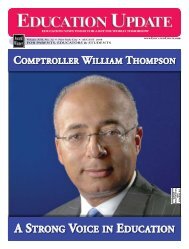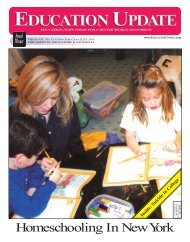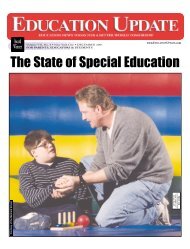Download PDF - Education Update
Download PDF - Education Update
Download PDF - Education Update
You also want an ePaper? Increase the reach of your titles
YUMPU automatically turns print PDFs into web optimized ePapers that Google loves.
12<strong>Education</strong> Equity AEDUCATION UPDATE | DECEMBER 2006Campaign for <strong>Education</strong> Equity atTeachers College: A Two Day SymposiumRyan Brenizer/Teachers CollegeRyan Brenizer/Teachers CollegeRyan Brenizer/Teachers CollegeLaurie TischJohn MerrowMichael RebellRichard RothsteinBy Liza YoungAt this year’s second annual Campaign for<strong>Education</strong>al Equity, sponsored by the LaurieM. Tisch Foundation, and hosted at the CowinCenter of Teachers College, experts on educationalpolicy gathered to discuss the state ofequity in education, an apt setting for the symposiumas indicated by Teachers College President,Susan Furhman, who kicked off the event, stating“from its inception Teachers College has focusedon research that is responsive to and shaped bythe needs of educational institutes and policymakers.”Michael A. Rebell, Executive Director of theCampaign for <strong>Education</strong>al Equity, underscoredkey findings from last year’s symposium—thegargantuan dollar cost of inequity in education,and presented directions taken this year:examining the current situation from a historicalcontext, with a comprehensive analysis of theNo Child Left Behind Act (NCLB), includingrecommended directions for the future in light ofits upcoming state of reauthorization.Dr. Amy Stuart Wells, Professor of Sociologyand <strong>Education</strong> and Coordinator of Policy Studiesat Teachers College, examined the history offederal involvement in educational and socialpolicy, asserting that the gap in academic performancestems from the historical trend in the USof placing the huge burden of reducing inequalityon school house doors, in contrast to other industrializednations which built and expanded socialwelfare programs to support citizen equality.Wells summarized Harold Belinsky’s comparisonof policies that further “absolute equality,”such as welfare programs, to those which further“equality of opportunity,” which is through education,and stated that the “profound question weneed to ask as we reflect on role of federal governmentin education and other social policies iswhether or not we can ever accomplish anythingresembling equality of opportunity through thepublic school system when children are comingthrough the door with day to day ‘levels of livingand being’ that are so profoundly unequal.”Wells’ conclusion is that the educational gapcan’t be closed until inequities outside of theclassroom are closed.She joined Rebell in applauding the efforts ofDr. Edmund Gordon, Director of the Instituteof Urban and Minority <strong>Education</strong> at TeachersCollege, in supporting supplemental educationfor underserved youth.In presenting his review of Wells’ paper, Dr.Gordon cited Mao Tse Tung’s notion of contradiction,that there’s “almost no aspect of life inwhich we do not see the opposite of what weare focused on.” Tying this with his perspectiveof Wells’ presentation, Gordon addressed theissue of dualism in education, noting LawrenceCremin’s interpretation of John Dewey’s accountof education and life, the cautionary notion that“it is a mistake to focus so sharply on schoolingthat we neglect many aspects of living that areeducative.” Gordon emphasized the need for supportingacademic development through propernourishment, keeping children healthy and use ofmuseums, libraries and faith based institutions.“As we roll out our discussions of comprehensiveeducation, you’ll see we are trying to break downthe separation between school and life and makelife a more active part of deliberate education,”stated Gordon.Session IIIn a forum on “Narrowing the AchievementGap,” moderated superbly by John Merrow,President of Learning Matters, Inc., expert panelistspresented their views on the performanceof special needs, English as a second language,and minority students within the framework ofNCLB.Dr. Eugene Garcia, Vice President for <strong>Education</strong>Partnerships, Arizona State University, creditedNCLB with drawing attention, for the first time,to the progress of English language learners(ELL), as well as other minorities. While therehave been increases in academic performancefor ELL students, a widening of the gap betweenEnglish learners and ELL exists especially inareas where use of the native language is prohibitedsuch as in California that adheres to an“English only” initiative based on the passage ofProposition 227 in 1998.Garcia indicated what Merrow termed a “complexityin education gap,” where there is evidencethat English language learners are doing well onthe basics, such as phonics, but fall behind in lateryears on more complex skills.His recommendations include early intervention—hecited an early education program forfour-year-olds which demonstrated a closing ofthe gap by kindergarten and training of professionalsfor English language learners, whichshould include support of the culture of Englishlanguage learners, using some aspects of theirlanguage, as NCLB does not prohibit assessmentin native language. Garcia reported on the positiveprogress of students in Texas who are doingwell in bilingual education and dual languageprograms.With reference to assessments for Englishlanguage learners, he advocates doing so in bothlanguages, and conducting assessments followingat least three years of study in English, to provideenough time to demonstrate improvement.Dr. Margaret J. McLaughlin, Professor andAssociate Director of the Institute for the Studyof Exceptional Children and Youth, University ofMaryland, provided an overview of the historyof special education, and its nature within thecontext of NCLB. She compared the progressof students with disabilities as similar to ELLBy Lisa K. Winklerstudents in terms of the “complexity in educationgap,” but raised the question of whether thegap has to do, in this case, with the nature of thestudent body, or with the nature of schools andcurriculum approaches. The passage of NCLB,with the call for increase in standards, requires,according to McLaughlin, that “all teachers needto know how to teach diverse children.”NCLB has also shed light on the performanceof the special education students, and theconsequent shift from individualized educationPerhaps no federal intervention in regulatingeducation has been more controversial than theNo Child Left Behind legislation. So it’s nosurprise that a symposium devoted to examiningNCLB generated debate on its merits, shortfalls,outlook and alternatives. Organized by TeachersCollege’s The Campaign for <strong>Education</strong> Equity,the two-day event, drew policy makers and educationexperts from around the nation.The following are comments from some speakers:Richard Rothstein, Economic Policy Institute,called for the repeal of NCLB. “The federalgovernment shouldn’t have any role in educationaccountability. It’s not justified morally or politically.It’s like trying to create democracy in Iraq.It’s completely unachievable. NCLB has alreadydone enormous harm to education. It’s causingsuccessful schools to be labeled as failuresand distorting teaching by dumbing down andteaching to the test.” He offered that educationalaccountability be the responsibility of each state.Robert Linn, University of Colorado, urged thataccountability be improved. He doesn’t expectNCLB to be repealed and offered some suggestions:establish more realistic expectations andobjective standards for measuring proficiency,grant schools more flexibility in how they’reassessed by allowing high performance areas tocompensate for lower performance areas, andexpand the curriculum for evaluating progressbeyond English and mathematic assessments.Frederick Hess, American Enterprise Institute,said “Democracy is a mess for a whole bunchof reasons. We can’t use statutes to achieve ouraspirations. We can’t unite the nation around anumerical goal. It’s not like John F. Kennedy’spost-Sputnik pledge that we’d put a man on themoon. Getting people literate isn’t the same as ascientific feat.”Gail Sunderman, Harvard University, criticizedNCLB for disproportionately focusing ontest-based outcomes without factoring in theneed for additional resources, both monetary andorganizational. “When the financial, human, andorganizational resources are insufficient, NCLBcan’t be adequately addressed.” She urged thatschools need more direct intervention and incentivesto improve.Manuel Rivera, Superintendent, Rochester, NY,shared how NCLB has impacted his large, urbandistrict. While he acknowledged that his staff allbelieves “all students can, will and do learn,” hefaults NCLB for its inconsistent standards andinflexible school assessment methods. He notedhow NCLB maintains 216 ways a K-8 school canbe cited for failing to meet NCLB criteria andfor a high school, it’s an additional 45. “Even ifwe’re making significant progress, the state tellsus to restructure. It’s demoralizing to the professionalsand families,” he said. He described howhis district set its own standards and adoptedmultiple assessments to judge its progress. Henoted how the achievement gap begins with childrenat age 4, if not before. “We’re working withcommunity and city organizations to provide programsfor very young children and parents. We’readdressing child abuse. We’re providing visitingnurses. We want to extend the school year to atleast 220 days. The community needs to embraceeducation as a value, “he said.Part of NCLB requires teachers nationwide toobtain “highly qualified” (HQT) status. SusannaLoeb, Stanford University, said HQT representeda weak instrument for ensuring quality teachingand was nearly impossible to quantify. “Justbecause a teacher is HQT, doesn’t mean he or sheis a good teacher,” she said.Barnett Berry, Center for Teaching Quality, Inc.offered a “Marshall Plan” to remedy the pitfallsof HQT. This would include improving datacollection on teachers’ credentials, improvingprofessional tests given by subject area, providingflexibility for school districts, particularly insmall, rural areas, and allowing teachers to be HQin different subjects and to teach interdisciplinarycourses.Karen Zumwalt, Teachers College, addressedthe difficulty attracting teachers to the toughestschool districts and urged that more resourcesbe directed to mentoring. She noted that programssuch as Teach for America and othersdon’t address teacher shortages. Furthermore, thetypical people that had gone into education in thepast, mostly women and blacks, were no longerdoing so. “The challenge is to make the professionattractive to all kinds of people,” she said.#programs to teaching special education studentsequivalent subject matter used in regular education.McLaughlin stated that many childrenend up in special education because of lackinggeneral education…and over-identification ofchildren as requiring special education as an easyway out of taking the time to properly classifystudents. “Due to NCLB you can no longer hide”under a special education category, McLaughlinindicated.Continued on page 13
















